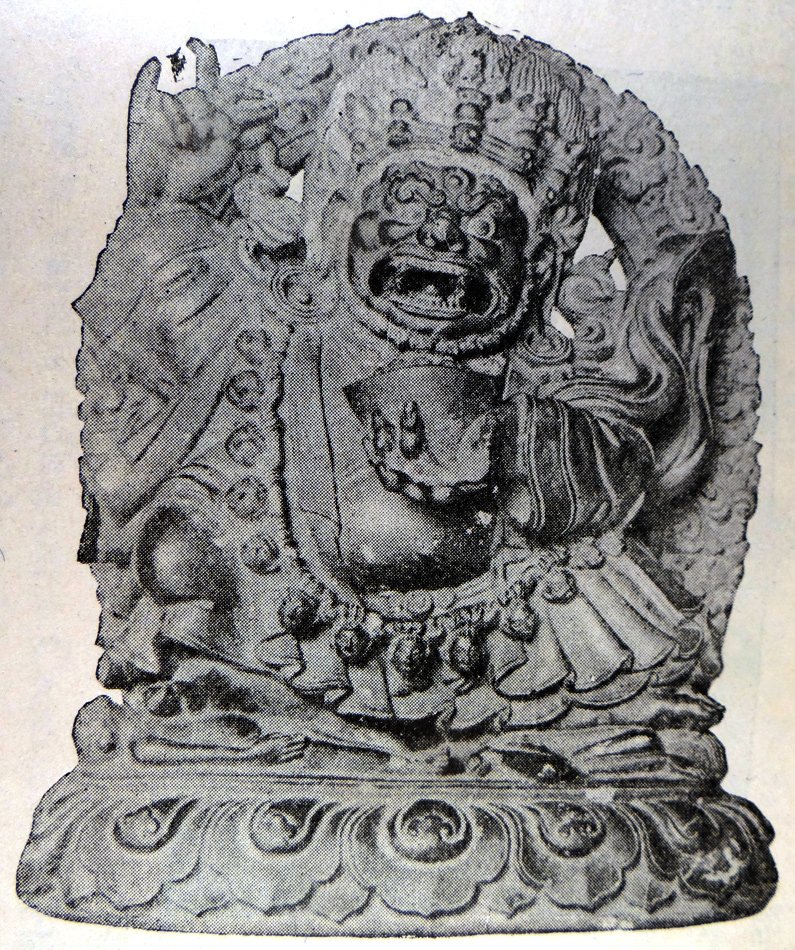The Indian Buddhist Iconography
by Benoytosh Bhattachacharyya | 1958 | 51,392 words | ISBN-10: 8173053138 | ISBN-13: 9788173053139
This page contains an iconography image of Hindu Gods: Two-armed Mahakala and represents figure 226 of the book Indian Buddhist Iconography, based on extracts of the Sadhanamala English translation. These plates and illustrations represent either photographs of sculptures or line-drawing reproductions of paintings or other representations of Buddhist artwork.
Figure 226 - Hindu Gods: Two-armed Mahākāla

Fig. 226: Two-armed Mahākāla
(Peiping)
It is not a fact that Hindu gods [viz., Mahākāla] were unknown in the Buddhist pantheon or that the Buddhist pantheon wholly consisted of Buddhist gods. [...] A perusal of the Niṣpannayogāvalī and especially the Dharmadhātuvāgīśvara-maṇḍala will show what a large number of Hindu deities was incorporated in the Mandala, and how this large number was tackled intelligently and fitted into the scheme of the Buddhist Maṇḍalas. [...] Amongst the Hindu deities incorporated into the Buddhist pantheon, three deities appear to be of great importance. These are Mahākāla the prototype of Śiva Mahādeva with the Triśūla as the recognition symbol, Gaṇapati the elephant-faced god, and Sarasvatī the Goddess of Learning with her characteristic Vīṇā. Separate Sādhanas are assigned to all of them, and even independent shrines for them are not wanting in the Buddhist countries of the North.
Mahākāla: In the Sādhanamālā as well as in the Niṣpannayogāvalī there are several descriptions of the ferocious Hindu god, Mahākāla. He has been given a variety of forms in these two works. He may have one face with two, four or six arms, or eight faces with sixteen aims. He is one of the many terrible deities of the Buddhist pantheon with ornaments of snakes, canine teeth, protruding belly and garment of tiger-skin.
Two-armed Mahākāla:
Colour: blue;
Arms: two;
Symbols: Kartri and Kapāla;
At least six Sādhanas in the Sādhanamālā describe the two-armed variety of Mahākāla. [...] Instead of the Kartri, Mahākāla carries the Triśūla in his right hand in some cases. Images of Mahākāla abound in Nepal and are found in large numbers in Buddhist temples, monasteries and even in the streets. Sometimes the head only is represented. Fig. 226 illustrates one of the finest specimens of Mahākāla beloning to the collection of Pandit Siddhiharṣa Vajrācārya of Nepal. Here the god tramples upon two figures representing two human corpses as required by the Sādhana. He wields the menacing Kartri in the right hand and the Kapāla full of blood in the left. Images of Mahākāla are also found in abundance in Tibet and China.
